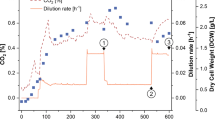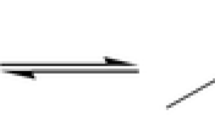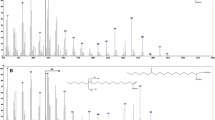Abstract
The contents and nature of the membrane lipids of Nanoarchaeum equitans and Ignicoccus sp. strain KIN4/I, grown at 90°C, and Ignicoccus sp. strain KIN4/I, cultivated at its lowest and highest growth temperatures (75°C and 95°C) were analyzed. Both organisms contained very simple and qualitatively identical assemblages of glycerol ether lipids, showing only differences in the amounts of certain components. LC–MS analyses of the total lipid extracts revealed that archaeol and caldarchaeol were the main core lipids. The predominant polar headgroups consisted of one or more sugar residues attached either directly to the core lipid or via a phosphate group. GC–MS analyses of hydrolyzed total lipid extracts revealed that the co-culture of N. equitans and Ignicoccus sp. strain KIN4/I, as well as Ignicoccus sp. strain KIN4/I grown at 90°C, contained phytane and biphytane in a ratio of approximately 4:1. Purified N. equitans cells and Ignicoccus sp. strain KIN4/I cultivated at 75°C and 95°C had a phytane to biphytane ratio of 10:1. Sugar residues were mainly mannose and small amounts of glucose. Consistent 13C fractionation patterns of isoprenoid chains of N. equitans and its host indicated that the N. equitans lipids were synthesized in the host cells.





Similar content being viewed by others
References
Barns SM, Delwiche CF, Palmers JD, Pace NR (1996) Perspectives on archaeal diversity, thermophily and monophyly from environmental rRNA sequences. Proc Natl Acad Sci USA 93:9188–9193
Bligh EG, Dyer WJ (1959) A rapid method of total lipid extraction and purification. Can J Biochem Physiol 37:911–917
De Rosa M, Gambacorta A (1986) Lipid biogenesis in archaebacteria. In: Kandler O, Zillig W (eds) Archaebacteria’85. Fischer, Stuttgart, pp 278–285
De Rosa M, Basso A, Gambacorta A, Holz I, Trincone A, Zillig W (1987) Lipid of Thermococcus celer, a sulfur-reducing Archaebacterium—structure and biosynthesis. Syst Appl Microbiol 9(1–2):1–5
De Rosa M, Gambacorta A, Huber R, Lanzotti V, Nicolaus B, Stetter KO, Trincone A (1988) A new 15,16-dimethyl-30-glyceroloxytriacontanoic acid from lipids of Thermotoga maritima. J Chem Soc Chem Commun 19:1300–1301
De Rosa M, Trincone A, Nicolaus B, Gambacorta A (1991) Archaebacteria: lipids, membrane structures, and adaptation to environmental stresses. In: DiPrisco G (ed) Life under extreme conditions. Springer, Berlin Heidelberg New York, pp 61–86
Ferrante G, Richards JC, Sprott GD (1990) Structures of polar lipids from the thermophilic, deep-sea archaeobacterium Methanococcus jannaschii. Biochem Cell Biol 68(1):174–283
Hafenbradl D, Keller M, Stetter KO (1996) Lipid analysis of Methanopyrus kandleri. FEMS Microbiol Lett 136(2):199–202
Hohn MJ, Hedlund BP, Huber H (2002) Detection of 16S-rDNA sequences representing the novel phylum “Nanoarchaeota”: indication for a wide distribution in high temperature biotopes. Syst Appl Microbiol 25:551–554
Huber R, Wilharm T, Huber D, Trincone A, Burggraf S, König H, Rachel R, Rockinger I, Fricke H, Stetter KO (1992) Aquifex pyrophilus gen. nov., sp. nov., represents a novel group of marine hyperthermophilic hydrogen-oxidizing bacteria. Syst Appl Microbiol 15:340–351
Huber H, Hohn MJ, Rachel R, Fuchs T, Wimmer VC, Stetter KO (2002) A new phylum of Archaea represented by a nanosized hyperthermophilic symbiont. Nature 417:63–67
Huber H, Hohn MJ, Stetter KO, Rachel R (2003a) The phylum Nanoarchaeota: present knowledge and future perspectives of a unique form of life. Res Microbiol 154:165–171
Huber H, Hohn MJ, Rachel R, Stetter KO (2003b) “Nanoarchaeota”. In: Dworkin M, Schleifer KH, Stackebrandt E (eds) The prokaryotes: an evolving electronic resource for the microbiological community, 3rd edn. Springer, Berlin Heidelberg New York www.prokaryotes.com(release 3.13, 12th May 2003)
Jahn U (2003) Physiologische, molekularbiologische und biochemische Untersuchungen am Organismensystem Nanoarchaeum equitans und Ignicoccus sp. KIN4/I. Diplomarbeit, Universität Regensburg
Jahnke LL, Eder W, Huber R, Hope JM, Hinrichs K, Hayes JM, Des Marais DJ, Cady S, Summons R (2001) Signature lipids and stable carbon isotope analysis of octopus spring hyperthermophilic communities compared with those of Aquificales representatives. Appl Environ Microbiol 67:5179–5189
Kates M (1978) The phytanyl ether-linked polar lipids and isoprenoid neutral lipids of extremely halophilic bacteria. Prog Chem Fats Other Lipids 15:301–342
Kates M (1986) Techniques of lipidology: isolation, analysis and identification of lipids. In: Bubon RH, van Knippenberg PH (eds) Laboratory techniques in biochemistry and molecular biology. Elsevier, Amsterdam
Kates M (1993) Membrane lipids of archaea. In: Kates M, Kushner DJ, Matheson AT (eds) The biochemistry of archaea (Archaebacteria). Elsevier, Amsterdam, pp 261–295
Koga Y, Nishihara M, Morii H, Akagawa-Matsushita M (1993) Ether polar lipids of methanogenic bacteria: structures, comparative aspects, and biosynthesis. Microbiol Rev 57:164–182
Koga Y, Kyuragi T, Nishihara M, Sone N (1998) Did archaeal and bacterial cells arise independently from non-cellular precursors? A hypothesis stating that the advent of membrane phospholipid with enantiomeric glycerophosphate backbones caused the separation of the two lines of descent. J Mol Evol 46(1):54–63
Kurr M, Huber R, König H, Jannasch HW, Fricke H, Trincone A, Kristjansson JK Stetter KO (1991) Methanopyrus kandleri, gen. and sp. nov. represents a novel group of hyperthermophilic methanogens, growing at 110°C. Arch Microbiol 156:239–247
Lange BM, Rujan T, Martin W, Croteau R (2000) Isoprenoid biosynthesis: the evolution of two ancient and distinct pathways across genomes. Proc Natl Acad Sci USA 97:13172–13177
Langworthy TA (1985) Archaebacteria. In: Woese CR, Wolfe RS (eds) The bacteria, vol 8. Academic, New York, pp 459–497
Nishihara M, Koga Y (1987) Extraction and composition of polar lipids from the archaebacterium, Methanobacterium thermoautotrophicum: effective extraction of tetraether lipids by an acidified solvent. J Biochem 101:997–1005
Rachel R, Wyschkony I, Riehl S, Huber H (2002) The ultrastructure of Ignicoccus: evidence for a novel outer membrane and for intracellular vesicle budding in an archaeon. Archaea 1:9–18
Rütters H, Sass H, Cypionka H, Rullkötter J (2001) Monoalkylether phospholipid in the sulfate-reducing bacteria Desulfosarcina variabilis and Desulforhabdus amnigenus. Arch Microbiol 176:435–442
Sprott GD, Meloche M, Richards JC (1991) Proportions of diether, macrocyclic diether, and tetraether lipids in Methanococcus jannaschii grown at different temperatures. J Bacteriol 173:3907–3910
Sprott GD, Agnew BJ, Girshchandra BP (1997) Structural features of ether lipids in the archaeobacterial thermophiles Pyrococcus furiosus, Methanopyrus kandleri, Methanothermus fervidus, and Sulfolobus acidocaldarius. Can J Microbiol 43:467–476
Stetter KO (1989) Extremely thermophilic chemolithoautotrophic archaebacteria. In: Schlegel HG, Bowien B (eds) Autotrophic bacteria. Science Tech/Springer, Madison/Berlin Heidelberg New York London Paris Tokyo, pp 167–175
Stetter KO (1995) Microbial life in hyperthermal environments. Am Soc Microbiol News 61:285–290
Sturt HF, Summons RE, Smith K, Elvert M, Hinrichs K-U (2004) Intact polar membrane lipids in prokaryotes and sediments deciphered by high-performance liquid chromatography/electrospray ionization multistage mass spectrometry—new biomarkers for biogeochemistry and microbial ecology. Rapid Commun Mass Spectrom 18(6):617–628
Sugai A, Sakuma R, Fukuda I, Itoh YH, Kon K, Ando S, Itoh (1995) The structure of the core polyol of the ether lipids from Sulfolobus acidocaldarius. Lipids 30:339–344
Summons RE, Franzman PD, Nichols PD (1998) Carbon isotopic fractionation associated with methylotrophic methanogenesis. Org Geochem 28:465–475
Waters E, Hohn MJ, Ahel I, Graham DE, Adams MD, Barnstead M, Beeson KY, Bibbs L, Bolanos R, Keller M, Kretz K, Lin X, Mathur E, Ni J, Podar M, Richardson T, Sutton GG, Simon M, Söll D, Stetter KO, Short JM, Noordewier M (2003) The genome of Nanoarchaeum equitans: insights into early archaeal evolution and derived parasitism. Proc Natl Acad Sci USA 100:12984–12988
Woese CR, Kandler O, Wheelis ML (1990) Towards a natural system of organisms: Proposal for the domains Archaea, Bacteria, and Eucarya. Proc Natl Acad Sci USA 87:4576–4579
Acknowledgments
The authors are grateful to Aurana Lewis for assistance with lipid isolation and analysis, Carolyn Colonero for assistance with isotopic analysis, and to Daniela Näther for preparation of the outer membrane of Ignicoccus sp. strain KIN4/I. Manuela Baumgartner kindly provided biomass from M. jannaschii, M. kandleri and M. fervidus. Dan Repeta (Woods Hole Oceanographic Institution) kindly provided carbohydrate standards. We thank Yanenk Hebting and Karl O. Stetter for fruitful discussions on the chemistry and microbiology issues encountered in this research. This work was supported by awards from the NASA Exobiology Program (RES) and the NASA Astrobiology Institute RES and by a grant of the Deutsche Forschungsgemeinschaft to HH (Förderkennzeichen HU 703/1-1). Helen Sturt is supported by the NASA Astrobiology Institute (Subsurface Biospheres Team at the University of Rhode Island), and we are especially grateful to Kai-Uwe Hinrichs and Waters Corporation for access to LC–MS equipment. We thank John Gibson and an anonymous reviewer who made numerous constructive suggestions that improved this manuscript.
Author information
Authors and Affiliations
Corresponding author
Rights and permissions
About this article
Cite this article
Jahn, U., Summons, R., Sturt, H. et al. Composition of the lipids of Nanoarchaeum equitans and their origin from its host Ignicoccus sp. strain KIN4/I. Arch Microbiol 182, 404–413 (2004). https://doi.org/10.1007/s00203-004-0725-x
Received:
Revised:
Accepted:
Published:
Issue Date:
DOI: https://doi.org/10.1007/s00203-004-0725-x




